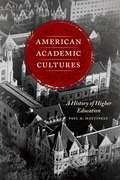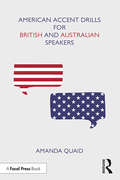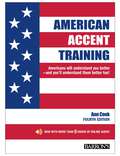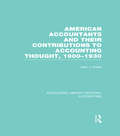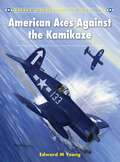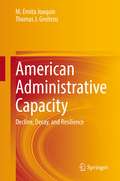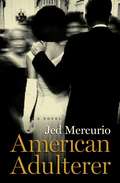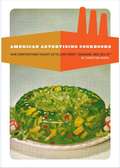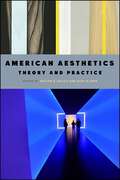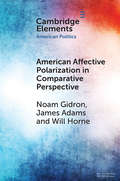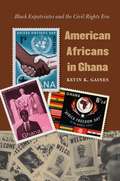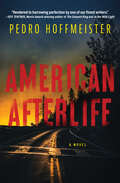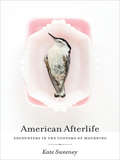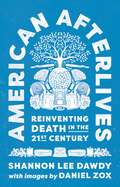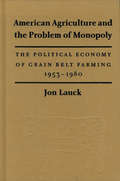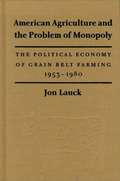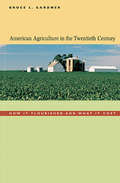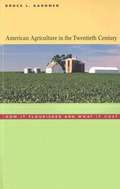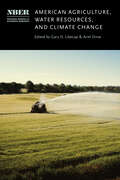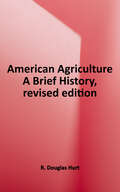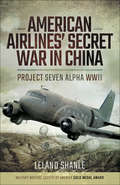- Table View
- List View
American Academic Cultures: A History of Higher Education
by Paul H. MattinglyAt a time when American higher education seems ever more to be reflecting on its purpose and potential, we are more inclined than ever to look to its history for context and inspiration. But that history only helps, Paul H. Mattingly argues, if it’s seen as something more than a linear progress through time. With American Academic Cultures, he offers a different type of history of American higher learning, showing how its current state is the product of different, varied generational cultures, each grounded in its own moment in time and driven by historically distinct values that generated specific problems and responses. Mattingly sketches out seven broad generational cultures: evangelical, Jeffersonian, republican/nondenominational, industrially driven, progressively pragmatic, internationally minded, and the current corporate model. What we see through his close analysis of each of these cultures in their historical moments is that the politics of higher education, both inside and outside institutions, are ultimately driven by the dominant culture of the time. By looking at the history of higher education in this new way, Mattingly opens our eyes to our own moment, and the part its culture plays in generating its politics and promise.
American Accent Drills for British and Australian Speakers
by Amanda QuaidAmerican Accent Drills for British and Australian Speakers provides a comprehensive guide to learning a "General American" accent, made specifically for native English speakers. Unlike most American accent guides, which are geared toward ESL learners, this handbook covers only the shifts that English speakers need to make – nothing more, nothing less. In addition to vowel and consonant drills, it covers the finer points of American intonation and elision, features that often elude English speakers of other dialects. Finally, it provides exercises for "owning" the dialect, finding authenticity and making it work for each individual actor in their own way. This is an excellent resource for students of speech and dialects, actors from the UK, Australia, and New Zealand, and advanced ESL learners who need to use an American accent on screen or on stage. American Accent Drills for British and Australian Speakers also includes access to downloadable audio files of the practice drills featured in the book, to help students practice and perfect their American accent.
American Accent Training With Audio, 4th edition: A Guide To Speaking And Pronouncing Colloquial American English
by Ann CookOptimized for use as an eBook, American Accent Training is a great training tool for classroom or for personal use! In recent years, this title has gained wide respect as a self-teaching program, but more and more speech trainers, teachers, and speech therapists report that they are also using it as a valuable teaching tool in their speech classes. This new edition now comes with audio. The program goes where no American accent training tool has gone before, providing highly innovative instruction for both students and business people. The structure of the book has been reorganized, offering students a much more clear and direct sequence of lessons and a path to better understanding. The downloadable audio component features professional male and female voices that have been carefully selected to represent authentic American pronunciation and intonation. Pronunciation exercises encompass all vowel sounds, consonants, blends, and diphthongs Emphasis on linking, or phonetically transcribed sound liaisons, help students "see" the correct sounds. Designed for foreign-born students and business people working, traveling, or studying in the United States and Canada. Supplementary materials include detailed nationality guides for 11 languages (Chinese, Japanese, Indian, Spanish, French, German, Russian, Korean, Arabic, the U.S. Southern accent, and African languages). More valuable features include access to a comprehensive website, and referral to a qualified telephone analyst for an individual diagnostic speech analysis.
American Accountants and Their Contributions to Accounting Thought: 1900-1930 (Routledge Library Editions: Accounting)
by John J. KahleAccounting carries with its history a vast number of ideas which have slowly developed along with it. This volume relates this history as it took place during the first three decades of the twentieth century in the United States. In particular it deals with those individuals who were for the most part responsible for it. It was these pioneers who recorded their observations of the actual workings of the myriad adaptations and new devices which had slowly eased their way into accounting theory and practice in the USA in the early twentieth century.
American Ace
by Marilyn NelsonThis riveting novel in verse, perfect for fans of Jacqueline Woodson and Toni Morrison, explores American history and race through the eyes of a teenage boy embracing his newfound identity Connor's grandmother leaves his dad a letter when she dies, and the letter's confession shakes their tight-knit Italian-American family: The man who raised Dad is not his birth father. But the only clues to this birth father's identity are a class ring and a pair of pilot's wings. And so Connor takes it upon himself to investigate--a pursuit that becomes even more pressing when Dad is hospitalized after a stroke. What Connor discovers will lead him and his father to a new, richer understanding of race, identity, and each other.From the Hardcover edition. Award finalist and Newbery Honor winner, has crafted a masterwork that combines contemporary fiction and history in a unique and thought-provoking way.From the Hardcover edition.
American Aces against the Kamikaze
by Edward Young Mark StylingThe Japanese High Command realized that the loss of Okinawa would give the Americans a base for the invasion of Japan. Its desperate response to the invasion of Okinawa was to unleash the full force of the Special Attack Units, known in the west as the Kamikaze ('Divine Wind'), in the hope of inflicting punishing casualties on the US Pacific fleet that in turn disrupted the invasion. In a series of mass attacks in between April and June 1945, more than 900 Kamikaze aeroplanes were shot down. Conventional fighters and bombers accompanied the Special Attack Units as escorts, and to add their own weight to the attacks on the US fleet. In the air battles leading up to the invasion of Okinawa, as well as those that raged over the island in the three months, that followed, and in strikes on Japanese airfields in Kyushu (the base of the Special Attack Units), the Japanese lost more than 7000 aircraft both in the air and on the ground. In the course of the fighting, 67 Navy, 21 Marine, and three USAAF pilots became aces, destroying at least five aircraft between March and June 1945. In many ways it was an uneven combat. While many regular Japanese Army and Navy aviators volunteered for the Special Attack Units, a large number of the pilots in the Special Attack Units were inexperienced and only recently out of flying training. They also often flew obsolete aircraft. These less experienced pilots were no match for the Hellcat, Corsair and Thunderbolt pilots who were at the peak of their game. Indeed, many of the latter had been flying fighters for two or more years, and had previous combat experience. On numerous occasions following these uneven contests, American fighter pilots would return from combat having shot down up to six Japanese aeroplanes during a single mission. Indeed, during the campaign 13 Navy, five Marine Corps and two USAAF pilots became 'aces in a day'.
American Administrative Capacity: Decline, Decay, and Resilience
by Thomas J. Greitens M. Ernita JoaquinThis volume proposes a capacity-centered approach for understanding American bureaucracy. The administrative institutions that made the country a superpower turned out to be fragile under Donald Trump’s presidency. Laboring beneath systematic accusations of deep statism, combined with a market oriented federal administration, bureaucratic capacity manifested its decay in the public health and constitutional cataclysms of 2020, denting America’s global leadership and contributing to its own people’s suffering. The authors combine interviews with a historical examination of federal administrative reforms in the backdrop of the recent pandemic and electoral tumult to craft a developmental framework of the ebb and flow of capacity. While reforms, large and small, brought about professionalization and other benefits to federal administration, they also camouflaged a gradual erosion when anti-bureaucratic approaches became entrenched. A sclerotic, brittle condition in the government’s capacity to work efficiently and accountably arose over time, even as administrative power consolidated around the executive. That co-evolutionary dynamic made federal government ripe for the capacity bifurcation, delegitimization, and disinvestment witnessed over the last four years. As the system works out the long-term impacts of such a deconstruction, it also prompts a rethinking of capacity in more durable terms. Calling attention to a more comprehensive appreciation of the dynamics around administrative capacity, this volume argues for Congress, citizens, and the good government community to promote capacity rebuilding initiatives that have resilience at the core. As such, the book will be of interest to citizens, public reformers, civic leaders, scholars and students of public administration, policy, and public affairs.
American Adulterer
by Jed MercurioAn explosive, provocative novel about the life and times-and sexual dalliances-of John F. Kennedy during his administration.
American Advertising Cookbooks: How Corporations Taught Us To Love Bananas, Spam, And Jell-o
by Christina WardAmerican Advertising Cookbooks: How Corporations Taught Us to Love Spam, Bananas, and Jell-O is a deeply researched and entertaining survey of twentieth century American food. Connecting cultural, social, and geopolitical aspects, author Christina Ward (Preservation: The Art & Science of Canning , Fermentation, and Dehydration, Process 2017) uses her expertise to tell the fascinating and often infuriating story of American culinary culture. Readers will learn of the role bananas played in the Iran-Contra scandal, how Sigmund Freud's nephew decided Carmen Miranda would wear fruit on her head, and how Puritans built an empire on pineapples. American food history is rife with crackpots, do-gooders, con men, and scientists all trying to build a better America-while some were getting rich in the process. Loaded with full-color images, Ward pulls recipes and images from her vast collection of cookbooks and a wide swath of historical advertisements to show the influence of corporations on our food trends. Though easy to mock, once you learn the true history, you will never look at Jell-O the same way again! American Advertising Cookbooks, How Corporations Taught Us To Love Bananas, Spam, and Jell&ndashO features full-color images and essays uncovering the origins of popular foods.
American Aesthetics: Theory and Practice (SUNY series in American Philosophy and Cultural Thought)
by Walter B. Gulick; Gary SlaterAlthough there are distinctly American artists—Walt Whitman, Herman Melville, Grandma Moses, Thomas Hart Benton, and Andy Warhol, for example—very little attention has been devoted to formulating any distinctively American characteristics of aesthetic judgment and practice. This volume takes a step in this direction, presenting an introductory essay on the possibility of such a distinctly American tradition, and a collection of essays exploring particular examples from a variety of angles. Some of the essays in this collection extend pragmatist and process insights about the important place aesthetics has in molding and assessing experience. Other essays examine the place of American aesthetics in relation to such particular forms of art as painting, literature, music, and film. Three essays attend to the aesthetic aspects of a flourishing life. In each of the essays, American aesthetics is understood to arise out of deeply felt personal, historical, and cultural backgrounds. Consequently, not only are such relatively abstract notions as harmony, fit, elegance, proportion, and the like involved in aesthetic judgment, but also religious, political, and social factors become embroiled in aesthetic discernment. Thus the ongoing pattern of American aesthetics is shown to be distinguishable from such other varieties of aesthetic thought as analytic aesthetics, New Criticism, and postmodern approaches to aesthetics.
American Affective Polarization in Comparative Perspective (Elements in American Politics)
by James Adams Noam Gidron Will HorneAmerican political observers express increasing concern about affective polarization, i.e., partisans' resentment toward political opponents. We advance debates about America's partisan divisions by comparing affective polarization in the US over the past 25 years with affective polarization in 19 other western publics. We conclude that American affective polarization is not extreme in comparative perspective, although Americans' dislike of partisan opponents has increased more rapidly since the mid-1990s than in most other Western publics. We then show that affective polarization is more intense when unemployment and inequality are high; when political elites clash over cultural issues such as immigration and national identity; and in countries with majoritarian electoral institutions. Our findings situate American partisan resentment and hostility in comparative perspective, and illuminate correlates of affective polarization that are difficult to detect when examining the American case in isolation.
American Africans in Ghana
by Kevin K. GainesIn 1957 Ghana became one of the first sub-Saharan African nations to gain independence from colonial rule. Over the next decade, hundreds of African Americans--including Martin Luther King Jr., George Padmore, Malcolm X, Maya Angelou, Richard Wright, Pauli Murray, and Muhammad Ali--visited or settled in Ghana. Kevin K. Gaines explains what attracted these Americans to Ghana and how their new community was shaped by the convergence of the Cold War, the rise of the U.S. civil rights movement, and the decolonization of Africa. Kwame Nkrumah, Ghana's president, posed a direct challenge to U.S. hegemony by promoting a vision of African liberation, continental unity, and West Indian federation. Although the number of African American expatriates in Ghana was small, in espousing a transnational American citizenship defined by solidarities with African peoples, these activists along with their allies in the United States waged a fundamental, if largely forgotten, struggle over the meaning and content of the cornerstone of American citizenship--the right to vote--conferred on African Americans by civil rights reform legislation.When the West African nation of Ghana gained its independence from British colonial rule in 1957, people of African descent the world over celebrated the new nation as a beacon for their aspirations for freedom and self-determination. Over the next decade, hundreds of African Americans--including Martin Luther King Jr., George Padmore, W. E. B. Du Bois, Malcolm X, Maya Angelou, Richard Wright, Pauli Murray, C. L. R. James, and Muhammad Ali--visited or settled in Ghana. Kevin K. Gaines explains what attracted these expatriates to Ghana and how their new community was shaped by the convergence of the Cold War, the rise of the U.S. civil rights movement, and the decolonization of Africa. -->
American Afterlife: A Novel
by Pedro HoffmeisterThe earthquake was just the beginning. Now, the true horror arrives in this unflinching, near-future thriller about family and survival, for fans of Chuck Wendig.The Pacific Northwest lies in ruins in the aftermath of the 9.2 Cascadia earthquake. There is a tsunami at the coast, annihilated infrastructure in all the towns and cities, and failed dams in the Oregon river valley where 15-year-old Cielo lives with her mother, a fearful evangelical who&’s become caught up in a fearsome cult called The Collection of Redeemed Souls. Cielo and her mother, Mexican citizens without U.S. papers, have always had their status teeter on the edge—and now it&’s about to plunge into the abyss.When the earthquake hits, Cielo&’s mother hasn&’t been home in days, but Cielo suspects that she&’s holed up with the cult and might even be dead. When the National Guard arrives to evacuate survivors, she stays behind in the flooded city to find her body. Members of The Collection of Redeemed Souls have also chosen to stay, and their disciples are capturing anyone still left behind and converting them to the cult by force. Entering a deadly game of cat-and-mouse, Cielo tries to evade the cult at every turn as she desperately searches for her mother&’s remains.With gunfights and mass killings engulfing the city, Cielo is one step away from her own demise, but the bonds of blood drive her on toward a confrontation with pure evil—and a final chance for her mother&’s redemption.
American Afterlife: Encounters in the Customs of Mourning
by Kate SweeneyAn award-winning writer explores the patchwork American cultural history of grieving the departed.One family inters their matriarch&’s ashes on the floor of the ocean. Another holds a memorial weenie roast each year at a green-burial cemetery. An 1898 ad for embalming fluid promises, &“You can make mummies with it!&” while a leading contemporary burial vault is touted as impervious to the elements. A grieving mother, 150 years ago, might spend her days tending a garden at her daughter&’s grave. Today, she might tend the roadside memorial she erected where her daughter was killed. One mother wears a locket containing her daughter&’s hair; the other, a necklace containing her ashes.What happens after someone dies depends on our personal stories and on where those stories fall in a larger tale―that of death in America. It&’s a powerful tale that we usually keep hidden from our everyday lives until we have to face it.American Afterlife by Kate Sweeney reveals this world through a collective portrait of Americans past and present who are personally involved with death: obit writers in the desert, an Atlantic funeral voyage, a fourth-generation funeral director―even a midwestern museum that shows us our death-obsessed Victorian progenitors. Each story illuminates details in another, revealing a landscape that feels at once strange and familiar, one that&’s by turns odd, tragic, poignant, and sometimes even funny.&“Sweeney&’s quest for the &“why&” behind mourning rituals has given us a book in the best tradition of narrative journalism.&”—Jessica Handler, author of Braving the Fire: A Guide to Writing about Grief and Loss
American Afterlives: Reinventing Death in the Twenty-First Century
by Shannon Lee DawdyA mesmerizing trip across America to investigate the changing face of death in contemporary lifeDeath in the United States is undergoing a quiet revolution. You can have your body frozen, dissected, composted, dissolved, or tanned. Your family can incorporate your remains into jewelry, shotgun shells, paperweights, and artwork. Cremations have more than doubled, and DIY home funerals and green burials are on the rise. American Afterlives is Shannon Lee Dawdy’s lyrical and compassionate account of changing death practices in America as people face their own mortality and search for a different kind of afterlife.As an anthropologist and archaeologist, Dawdy knows that how a society treats its dead yields powerful clues about its beliefs and values. As someone who has experienced loss herself, she knows there is no way to tell this story without also reexamining her own views about death and dying. In this meditative and gently humorous book, Dawdy embarks on a transformative journey across the United States, talking to funeral directors, death-care entrepreneurs, designers, cemetery owners, death doulas, and ordinary people from all walks of life. What she discovers is that, by reinventing death, Americans are reworking their ideas about personhood, ritual, and connection across generations. She also confronts the seeming contradiction that American death is becoming at the same time more materialistic and more spiritual.Written in conjunction with a documentary film project, American Afterlives features images by cinematographer Daniel Zox that provide their own testament to our rapidly changing attitudes toward death and the afterlife.
American Agriculture and the Problem of Monopoly: The Political Economy of Grain Belt Farming, 1953-1980
by Jon K. LauckThe breathtaking number of mergers and joint ventures among agribusiness firms has left independent American farmers facing the power of an increasingly concentrated buying sector. The origin of farmers’ concern with such economic concentration dates back to protests against meatpackers and railroads in the late nineteenth century. Jon Lauck examines the dimensions of this problem in the American Midwest in the decades following World War II. He analyzes the nature of competition within meat-packing and grain markets. In addition, he addresses concerns about corporate entry into production agriculture and the potential displacement of a production system defined by independent family farms. Lauck also considers the ability of farmers to organize in order to counter the market power of large-scale agribusiness buyers. He explores the use of farmer cooperatives and other mechanisms which may increase the bargaining power of farmers. The book offers the first serious historical examination of the National Farmers Organization, which fully embraced the bargaining power cause in the postwar period. Lauck finds that independent farmers’ attempts at organization have been more successful than previously recognized, but he also shows that their successes have been undermined by the growing concentration and power of agri-business firms, justifying a new approach to antitrust law in agricultural markets.
American Agriculture and the Problem of Monopoly: The political economy of grain belt farming, 1953-1980
by Jon LauckThe breathtaking number of mergers and joint ventures among agribusiness firms has left independent American farmers facing the power of an increasingly concentrated buying sector. The origin of farmers’ concern with such economic concentration dates back to protests against meatpackers and railroads in the late nineteenth century. Jon Lauck examines the dimensions of this problem in the American Midwest in the decades following World War II. He analyzes the nature of competition within meat-packing and grain markets. In addition, he addresses concerns about corporate entry into production agriculture and the potential displacement of a production system defined by independent family farms. Lauck also considers the ability of farmers to organize in order to counter the market power of large-scale agribusiness buyers. He explores the use of farmer cooperatives and other mechanisms which may increase the bargaining power of farmers. The book offers the first serious historical examination of the National Farmers Organization, which fully embraced the bargaining power cause in the postwar period. Lauck finds that independent farmers’ attempts at organization have been more successful than previously recognized, but he also shows that their successes have been undermined by the growing concentration and power of agri-business firms, justifying a new approach to antitrust law in agricultural markets.
American Agriculture in the Twentieth Century: How It Flourished and What It Cost
by Bruce L. GardnerAmerican agriculture in the twentieth century has given the world one of its great success stories, a paradigm of productivity and plenty. Yet the story has its dark side, from the plight of the Okies in the 1930s to the farm crisis of the 1980s to today's concerns about low crop prices and the impact of biotechnology. Looking at U.S. farming over the past century, Bruce Gardner searches out explanations for both the remarkable progress and the persistent social problems that have marked the history of American agriculture. Gardner documents both the economic difficulties that have confronted farmers and the technological and economic transformations that have lifted them from relative poverty to economic parity with the nonfarm population. He provides a detailed analysis of the causes of these trends, with emphasis on the role of government action. He reviews how commodity support programs, driven by interest-group politics, have spent hundreds of billions of dollars to little purpose. Nonetheless, Gardner concludes that by reconciling competing economic interests while fostering productivity growth and economic integration of the farm and nonfarm economies, the overall twentieth-century role of government in American agriculture is fairly viewed as a triumph of democracy.
American Agriculture in theTwentieth Century: How It Flourished and What It Cost
by Bruce L. GardnerAmerican agriculture in the twentieth century has given the world one of its great success stories, a paradigm of productivity and plenty. Yet the story has its dark side, from the plight of the Okies in the 1930s to the farm crisis of the 1980s to today's concerns about low crop prices and the impact of biotechnology. Looking at U. S. farming over the past century, Bruce Gardner searches out explanations for both the remarkable progress and the persistent social problems that have marked the history of American agriculture. Gardner documents both the economic difficulties that have confronted farmers and the technological and economic transformations that have lifted them from relative poverty to economic parity with the nonfarm population. He provides a detailed analysis of the causes of these trends, with emphasis on the role of government action. He reviews how commodity support programs, driven by interest-group politics, have spent hundreds of billions of dollars to little purpose. Nonetheless, Gardner concludes that by reconciling competing economic interests while fostering productivity growth and economic integration of the farm and nonfarm economies, the overall twentieth-century role of government in American agriculture is fairly viewed as a triumph of democracy.
American Agriculture, Water Resources, and Climate Change (National Bureau of Economic Research Conference Report)
by Gary D. Libecap and and Ariel DinarA collection of the most advanced and authoritative agricultural-economic research in the face of increasing water scarcity. Agriculture has been critical in the development of the American economy. Except in parts of the western United States, water access has not been a critical constraint on agricultural productivity, but with climate change, this may no longer be the case. This volume highlights new research on the interconnections between American agriculture, water resources, and climate change. It examines climatic and geologic factors that affect the agricultural sector and highlights historical and contemporary farmer responses to varying conditions and water availability. It identifies the potential effects of climate change on water supplies, access, agricultural practices, and profitability, and analyzes technological, agronomic, management, and institutional adjustments. Adaptations such as new crops, production practices, irrigation technologies, water conveyance infrastructure, fertilizer application, and increased use of groundwater can generate both social benefits and social costs, which may be internalized with various institutional innovations. Drawing on both historical and present experiences, this volume provides valuable insights into the economics of water supply in American agriculture as climate change unfolds.
American Agriculture: A Brief History
by R. Douglas HurtThis book is from the prehistoric period through the twentieth century and is written for anyone coming to this subject for the first time. American Agriculture is a story of considerable achievement and success, but it is also a story of greed, racism, and violence. Hurt offers a provocative look at a history that has been shaped by the best and worst of human nature. Here is the background essential for understanding the complexity of American agricultural history, from the transition to commercial agriculture during the colonial period to the failure of government policy following World War II. Complete with maps, drawings, and over seventy splendid photographs, this revised edition closes with an examination of the troubled landscape at the turn of the twenty-first century. It also provides a ready reference to the economic, social, political, scientific, and technological changes that have most affected farming in America and the contributions of African Americans, Native Americans, and women. This survey will serve as a text for courses in the history of American agriculture and rural studies as well as a supplementary text for economic history and rural sociology courses.
American Airline's Secret War in China: Project Seven Alpha, WWII
by Leland ShanleIn late 1941, President Roosevelt agonized over the rapid advances of the Japanese forces in Asia; they seemed unstoppable. He foresaw their intentions of taking India and linking up with the two other Axis Powers, Germany and Italy, in an attempt to conquer the Eastern Hemisphere. US naval forces had been surprised and diminished in Pearl Harbor and the army was not only outnumbered but also ill-prepared to take on the invading hoards. One of Roosevelts few options was to form a defensive line on the eastern side of the Patkai and Himalayan Ranges; there, he could look for support from the Chinese and Burmese. It was the only defence to a Japanese invasion of India.To support and supply the troops who were fighting in hostile jungle terrain, where overland routes had been cut off, he desperately needed to set up an air supply from Eastern India. His problem was lack of aircraft and experienced pilots to fly the dangerous Hump, over the worlds highest mountains. Hence the inception of Operation Seven Alpha, a plan to enlist the aircraft—DC-3s—and the pilots—veterans of World War One—of American Airlines. This newly formed elite Squadron would fly the medium-range aircraft in a series of long-distance hops across the Pacific and Southern Asia to the Assam Valley in India. They would then create and operate the vital supply route, carrying arms, ammunition and food Eastward to the Allied bases, before returning with wounded personnel. This is the story of that little-known operation, carried out in the early days of the Burma Campaign.The book is based on first-hand experiences of those who were involved, and it serves as a fitting tribute to the bravery and inventiveness of a band of men who answered their countrys desperate call at the outset of the war against Japan in Asia.
American Airlines in 2011
by Willy ShihThe American Airlines in 2011 case was developed to provide a setting for the comparative analysis of two very different business models in the U.S. domestic airline industry-the network carrier and the low cost carrier (LCC). These models offer very different value propositions. Firms allocate resources into distinctively different processes, and they earn returns using parallel but different profit models. Yet while most scholars view the LCC model as disruptive, the two different models have been able to co-exist for over forty years, albeit with substantial evolution. By unpacking how one of the major network carriers was able to evolve its model successfully for such a long time before industry structural changes necessitated a radical overhaul, the cases seek to give students insights into how the different business models were established, how competitive forces have driven their evolution, and the importance of constantly evolving and tuning a firm's model.
American Airlines' Value Pricing (A)
by Alvin J. Silk Steven C. MichaelIn April 1992, American Airlines launched "Value Pricing" -- a radical simplification of the complex pricing structure that had evolved over more than a decade following deregulation of the U.S. domestic airline industry. American expected that the new pricing structure would benefit consumers and restore profitability to both American and the industry as a whole. The critical issue raised is: Would American's bold initiative work?
